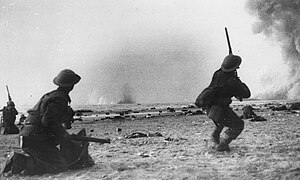
Back Slag van Duinkerken Afrikaans معركة دنكيرك Arabic Dünkerk uğrunda döyüş Azerbaijani دونکرک دؤیوشو AZB Emgann Dukark Breton Batalla de Dunkerque Catalan Gubat sa Dunkerque CEB Bitva u Dunkerque Czech Brwydr Dunkirk Welsh Slaget ved Dunkerque Danish
| Battle of Dunkirk | |||||||
|---|---|---|---|---|---|---|---|
| Part of the Battle of France in the Second World War | |||||||
 "Soldiers from the British Expeditionary Force fire at low flying German aircraft during the Dunkirk evacuation" – Soldiers were strafed and bombed by German aircraft | |||||||
| |||||||
| Belligerents | |||||||
|
| |||||||
| Commanders and leaders | |||||||
| Strength | |||||||
|
approx. 400,000 338,226 evacuated | approx. 800,000 | ||||||
| Casualties and losses | |||||||
|
Estimated total casualties | ||||||
| Civilian casualties: 1,000 civilians killed during air raids | |||||||
The Battle of Dunkirk (French: Bataille de Dunkerque) was fought around the French port of Dunkirk (Dunkerque) during the Second World War, between the Allies and Nazi Germany. As the Allies were losing the Battle of France on the Western Front, the Battle of Dunkirk was the defence and evacuation of British and other Allied forces to Britain from 26 May to 4 June 1940.
After the Phoney War, the Battle of France began in earnest on 10 May 1940. To the east, the German Army Group B invaded the Netherlands and advanced westward. In response, the Supreme Allied Commander, French General Maurice Gamelin, initiated "Plan D" and British and French troops entered Belgium to engage the Germans in the Netherlands. French planning for war relied on the Maginot Line fortifications along the German–French border protecting the region of Lorraine but the line did not cover the Belgian border. German forces had already crossed most of the Netherlands before the French forces had arrived. Gamelin instead committed the forces under his command – three mechanised forces, the French First and Seventh Armies and the British Expeditionary Force (BEF) – to the River Dyle. On 14 May, German Army Group A burst through the Ardennes and advanced rapidly westward toward Sedan, turning northward to the English Channel, using Generalfeldmarschall Erich von Manstein's plan Sichelschnitt (under the German strategy Fall Gelb), effectively flanking the Allied forces.[6]
A series of Allied counter-attacks, including the Battle of Arras, failed to sever the German spearhead, which reached the coast on 20 May, separating the BEF near Armentières, the French First Army, and the Belgian Army further to the north from the majority of French troops south of the German penetration. After reaching the Channel, the German forces swung north along the coast, threatening to capture the ports and trap the British and French forces.
In one of the most debated decisions of the war, the Germans halted their advance on Dunkirk. What became known as the "Halt Order" did not originate with Adolf Hitler. Generaloberst (Colonel-General) Gerd von Rundstedt and Generaloberst Günther von Kluge suggested that the German forces around the Dunkirk pocket should cease their advance on the port and consolidate to avoid an Allied breakout. Hitler sanctioned the order on 24 May with the support of the Oberkommando der Wehrmacht (German high command). The army was to halt for three days, which gave the Allies sufficient time to organise the Dunkirk evacuation and build a defensive line. While more than 330,000 Allied troops were rescued,[7] the British and French sustained heavy casualties and were forced to abandon nearly all their equipment; around 16,000 French and 1,000 British soldiers died during the evacuation. The British Expeditionary Force alone lost some 68,000 soldiers during the French campaign.
- ^ Ellis, Major L F. "The War in France and Flanders 1939–1940 (Chapter XII: Dunkirk Bethune and Ypres)". History of the Second World War. Archived from the original on 30 May 2007 – via Hyperwar Foundation.
- ^ a b Hooton 2010, p. 71.
- ^ a b Murray 2002, p. 42 (1985 ed.)
- ^ Franks 2008, pp. 33–39.
- ^ Franks 2008, p. 160.
- ^ MacDonald 1986, p. 8.
- ^ Frieser 2005, pp. 291–292.